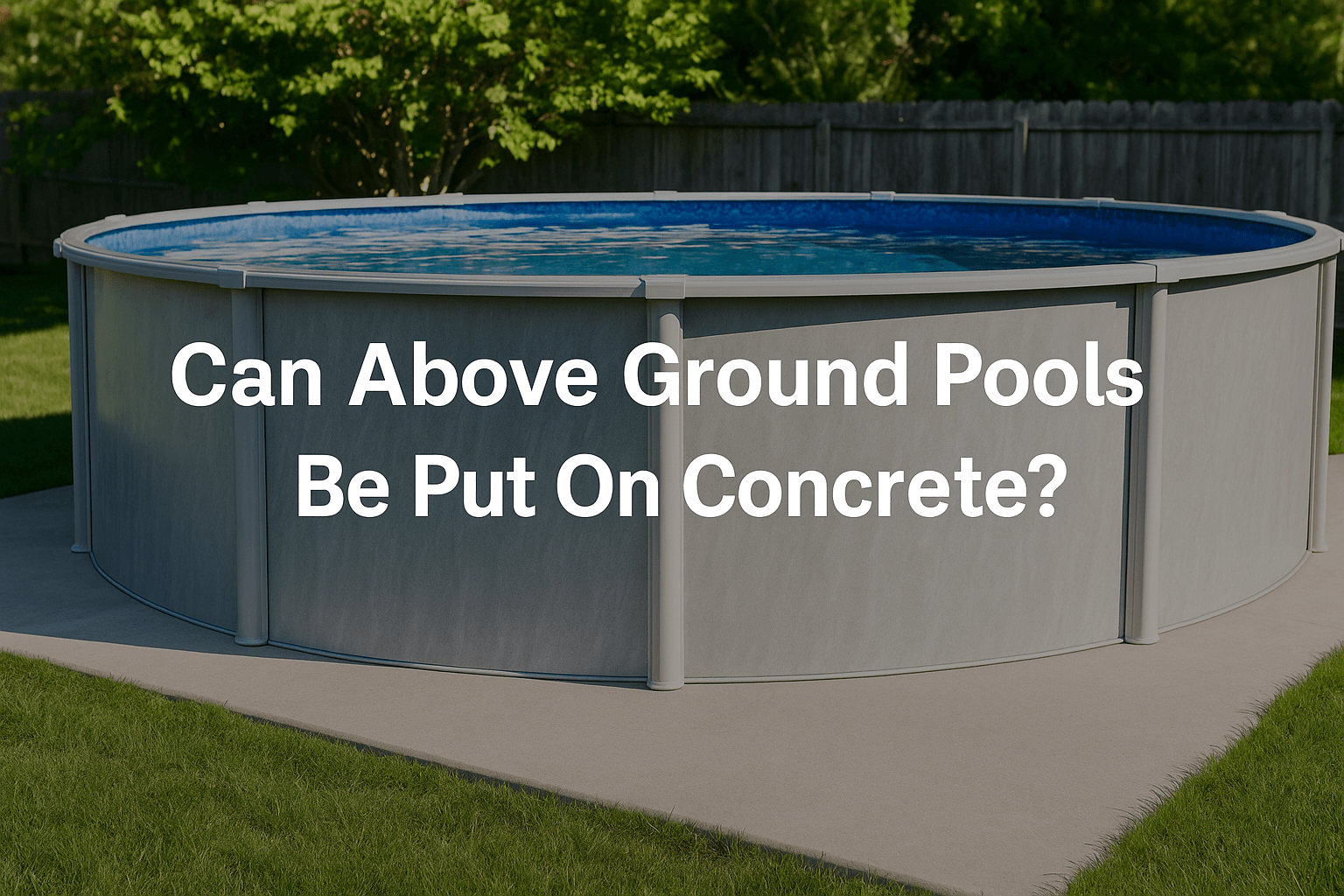
Can Above Ground Pools Be Put On Concrete?
Concrete jungle or backyard oasis? If you’re eyeing a deep above ground pool but stuck with a concrete patio, here’s the splashy truth: yes, you can put a pool on concrete—with a few smart tweaks. Want it safe, stable, and splash-proof? Stick around for the must-know tips.
The Benefits of a Concrete Pad for Your Above Ground Pool
Providing a Perfectly Level and Stable Surface
One of the biggest perks of concrete? It stays exactly where you put it.
Unlike soil or sand, it doesn’t shift, sink, or surprise you with sudden dips. A level slab gives your pool a solid, stable base from day one. That means less leaning, fewer worries, and no late-night “why’s the water tilting?” moments.
And when you’re filling up a deep above ground pool? That stability really matters.
Preventing Ground Shifting, Settling, and Unevenness
If you’ve ever walked across a lawn and felt a soft spot, you’ll know what we mean.
Soil moves. Rain comes. Things settle. That’s a nightmare for pool setups. Concrete solves this by giving you a firm, unmoving base — so your pool won’t sink on one side halfway through summer.
Protection Against Punctures from Roots, Rocks, or Pests
No one wants to deal with a torn pool liner halfway through a heatwave.
Concrete keeps you protected from sneaky roots, stones, or burrowing creatures. There’s nothing underneath to poke through or damage the liner — just a smooth, safe barrier.
It’s like giving your pool a shield underneath its skin.
Easier Maintenance and Weed Prevention Around the Pool Base
With a concrete base, keeping things clean is a breeze.
No mud, no weeds sneaking in, and definitely no patchy grass turning into a swampy mess. You’ll spend more time enjoying your pool and less time trimming or sweeping around it.
Plus, it makes your whole setup look sleek and intentional.

Why Concrete is Often a Preferred Base Option
Durability and Longevity of the Foundation
Concrete lasts. It’s not a one-summer wonder.
Once it’s down and done right, you won’t need to worry about replacing your base in a couple of years. Many families have kept the same slab under their pool for 10+ years with zero issues.
Think of it as a long-term investment in pool fun.
Reduced Risk of Liner Damage
The trick here is preparation. Smooth the surface and add a protective layer — and your liner stays safe.
There’s less rubbing, less risk of sharp surprises, and a much longer life for that expensive pool liner. We’ve heard from families who used a foam pad on top of their concrete and never had to patch a single tear.
Small step, big win.
Enhanced Stability for the Entire Pool Structure
Deep above ground pools hold a lot of water. A lot.
That weight needs something solid underneath. Concrete gives your pool the stability it needs to stay upright, even when it’s full of kids doing cannonballs and inflatable flamingos bouncing around.
No tilting. No sagging. Just solid swimming.
Preparing and Protecting Your Pool When Using a Concrete Base
Essential Concrete Pad Specifications and Preparation
Ensuring the Concrete Slab is Perfectly Level
Before anything touches the concrete, make sure it’s flat.
Not “close enough” — properly level. A slight slope or bump can throw the whole structure off and cause pressure points on the liner.
Use a spirit level or hire a pro if you’re unsure. This isn’t the step to wing it.
Proper Thickness and Reinforcement for Weight Distribution
Concrete needs to be thick enough to handle the load.
A deep pool full of water (and people) can weigh several tonnes. You’re looking for a slab at least 4 inches thick — ideally reinforced with rebar or mesh.
Without it, cracks and shifts can creep in over time.
Adequate Drainage Planning Around the Pad (Slight Slope Away from Pool)
Water and concrete don’t always mix well. So, make sure there’s somewhere for rainwater or splashes to go.
A slight slope away from the pool helps direct water away from the base, preventing puddles and long-term damage. Think of it like a raincoat for your foundation.
Curing Time Before Pool Installation
Fresh concrete needs time to cure.
It might look dry after a couple of days, but it’s still hardening inside. Wait at least 7 days — ideally longer — before placing a pool on it.
Rushing this step can lead to cracks and disappointment down the line.

Protecting the Pool Liner on Concrete
The Absolute Necessity of a Pool Pad or Ground Cloth
Never, ever skip this step.
Putting a liner directly on concrete is asking for trouble. A thick pool pad or heavy-duty ground cloth cushions the liner and adds an extra layer of protection.
It’s a simple barrier that makes a huge difference.
Adding a Layer of Sand or Foam Underneath the Liner for Cushioning
Some pool owners add a layer of sand or foam for extra comfort. It’s a great way to reduce pressure and make the bottom feel soft underfoot.
Kids love it, feet love it, and your liner will too.
Foam boards or rolls are easy to install and work wonders on hard concrete.
Preventing Friction and Abrasion Damage to the Liner
Over time, even smooth concrete can cause wear. Movement, splashing, and foot traffic all add up.
Your liner deserves a bit of cushioning to stop it from wearing thin or tearing. Think of it like a mattress topper — not essential, but once you have it, you’ll never go back.
Potential Drawbacks and Considerations
Higher Upfront Cost Compared to Sand or Stone
Laying a proper concrete slab isn’t cheap. It’s more than just a bag of sand and a rake.
Between materials, labour, and prep, it adds to your pool’s setup cost. But if you’re thinking long-term, it pays off in durability and peace of mind.
Potential for Concrete Cracking (If Not Poured Correctly)
A poorly poured slab can crack — and that’s not a great base for anything.
If you’re DIY-ing, be sure to follow best practices. If in doubt, call in a professional. It’s much cheaper to do it right the first time than to fix a failed foundation later.
Heat Retention (Concrete Can Get Hot Underfoot)
On hot summer days, concrete can feel like a frying pan.
This can warm the pool water — which might be great early in the season — but it also makes walking barefoot around the pool uncomfortable. Pool mats or artificial turf can help solve this issue.
Amazon Paddling Pool
If you’ve seen an Amazon paddling pool and wondered if it’s suitable for concrete — it is.
These lightweight, temporary pools work fine on a flat patio or slab, as long as the surface is smooth and free from sharp edges.
That said, paddling pools are more of a short-term fix.
If you’re looking for something sturdier, safer, and made to last, brands like Bestway or Intex offer deeper, reinforced above ground pools that transform your space from splash pad to backyard retreat.

Alternative Foundations and Making the Best Choice
Common Alternatives to Concrete
Compacted Sand Base (Most Popular and Affordable)
The go-to for many pool owners. Cheap, easy to level, and simple to adjust.
But it can shift, erode, or become uneven over time — especially with heavy rain or rowdy swimmers.
Crushed Stone or Graded Stone Dust
These drain better than sand and don’t shift quite as easily.
They’re a solid middle ground between budget and durability — just make sure they’re well compacted.
Paver Base Systems
A tidy option that looks great in gardens.
Pavers are removable, reusable, and give excellent drainage. They do need careful levelling, but they strike a nice balance between concrete’s strength and sand’s simplicity.
Deciding on the Right Foundation for Your Pool
Budget and DIY Capability
If you’ve got the tools and confidence, you might opt for pavers or sand.
If you’re looking for a long-term fix and are happy to spend more upfront, concrete is hard to beat.
Local Ground Conditions and Drainage Needs
Live somewhere rainy? Concrete or pavers might make more sense.
Dry, flat back garden? Sand could do just fine.
Pool Type and Manufacturer Recommendations
Always check the manual. Some deep above ground pools specifically recommend concrete or reinforced surfaces.
Don’t skip this — voiding a warranty isn’t worth it.
Long-Term Durability and Maintenance Expectations
Think about the years ahead.
Do you want to relevel your base every summer? Or lay it once and forget it?
If you’re in this for the long haul, concrete could be the set-it-and-forget-it solution you’re looking for.
Have you checked out our other posts?
Can You Put An Above Ground Pool In The Ground?
Can Above Ground Pools Be Moved?
Does An Above Ground Pool Need A Pump?



Leave a comment